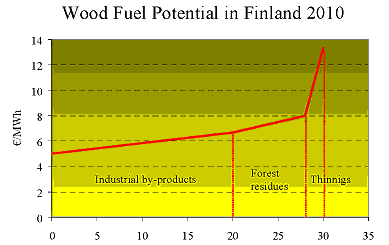 |
FEEDSTOCK DELIVERY AND ASSESSMENT- FINLANDWood fuels consumption in Finland has been increasing since the early 1990´s.
The share of wood and wood based fuels in Finland is as high as 19 % of the total primary energy demand. This includes the by-products of pulp and paper industry (black liquor, bark fiber sludges) as well as of the sawmill industry (bark, sawdust).
The current wood fuels use is about 23 TWh/a. Less than 10 % of the total was forestry residues in 2001, but this fraction is increasing.

Source: VTT Processes
The logging residues exhibit the largest potential in the development of wood fuels because the industrial by-products have very stable market and their amount will not increase unless new mills are established.
Wood fuel potential and the corresponding fuel cost is given:

TWh/aSource: VTT Processes
Industrial by-products and forest residues are considered economically feasible. Considering wood from thinning the price increases sharply because of the cutting stage, which adds some 4 €/MWh to the overall cost. For the residues this stage accounts only about 0.2 €/MWh to the overall cost.
Therefore the logging residues were chosen as the raw material for the pyrolysis plant.
The residues consist of the tops and branches mainly from spruce.
The share of the residues is about one third of the total wood biomass. In terms of energy units it is about 100 MWh per hectare. During the loggings the tops and branches are pre-collected into heaps in order to facilitate their drying and later collection. The residues are colleted with the help of normal farm tractor equipped with a special trailer and a small lifting crane. The net load of the trailer is 9 tonnes of residues which are transported either to the road side or to the nearest storage terminal. The typical transportation distance in the forest is from 500 meters up to 1500 metres. The vehicle can be used also in the public roads.
The next phase is the chipping of the residues to meet the particle size of the pyrolysis plant, normally about 40 millimetres plus minus 10 millimetres, depending on the chipping machine. The moisture content of the fresh logging residues is 55 weight percent and thus the heating value is very low, about 5 MJ/kg or 1.3 MWh/tonne. If the residues are allowed to dry in the storage, their moisture content will drop down to 25-30 percent increasing the heating value up to 7-8 MJ/kg or 1.9-2.1 MWh/tonne.
Due to the overall low energy density, the logging residues were collected from an area having a radius less than 40 kilometers from the pyrolysis plant. The transportation of the logging residue chips to the plant was carried out with trucks having 40 cubic meters capacity.

